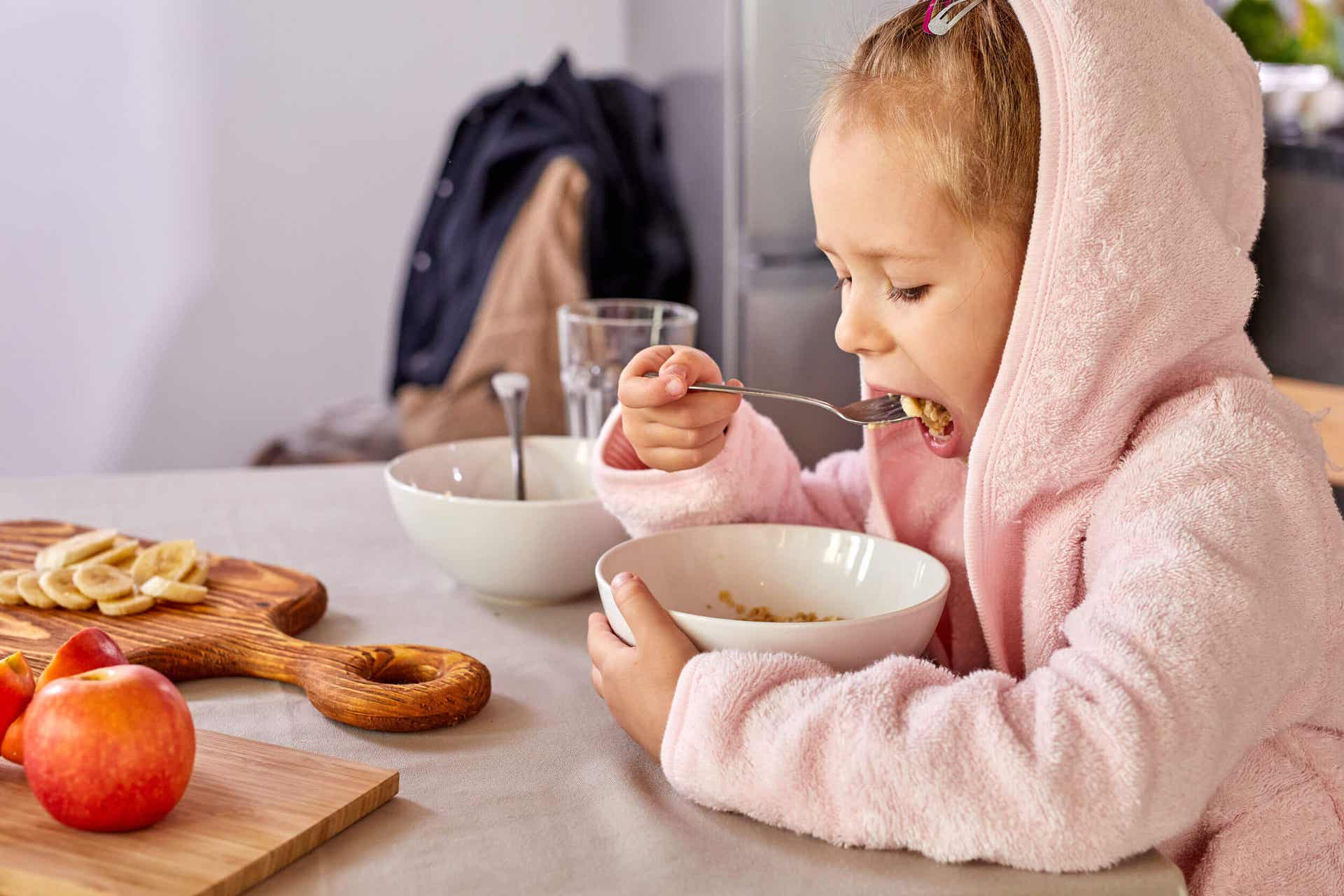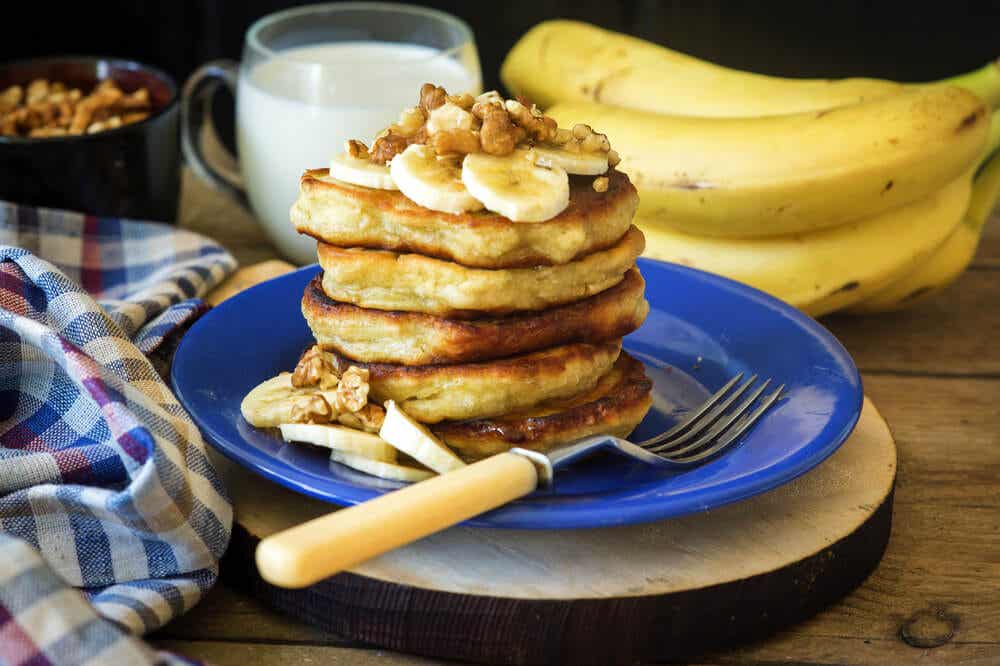Oatmeal's a Good Choice for Babies and Children

Oatmeal’s one of the highest quality cereals available. Among other virtues, this food has a lot of soluble fiber inside that’s capable of fermenting in the intestine and providing great benefits to our microbiota. Not only is it an excellent source of energy, but it also helps to improve the functioning of the body in general. All this means that oatmeal’s a good choice for babies and children.
Another great advantage of oats is that they undergo little adulteration during industrial processing. It’s most commonly consumed as is, although it’s also possible to find it in the form of flour or in some products with added sugar. Even so, it’s not refined as much as wheat, and this allows it to retain its fiber.
Why oatmeal’s a good choice for babies and children
As a general rule, we can say that oatmeal’s a good choice because it consists of complex, high-quality carbohydrates with a low glycemic index. These substances pass into the bloodstream very slowly, so they don’t alter blood glucose levels (glycemia) abruptly.
Therefore, oats protect metabolic health in the long term. In contrast, simple sugars or carbohydrates with a high glycemic index are associated with an increased risk of developing type 2 diabetes (Lean, 2016).
How should infants and children consume oatmeal?

The best way to consume oatmeal is in flaked form, to make good use of all the characteristics of the cereal, including its fiber.
However, the consumption of oatmeal flakes may be unsuitable for babies, as they have limited chewing ability and can easily choke. So, a good option is to give it in the form of flour or crushed oatmeal.
Thanks to soluble fiber, when oatmeal reaches the child’s intestine, it ferments and feeds the intestinal microbiota. According to research published in The Journal of Nutritional Biochemistry, the beta-glucans in oats promote the growth of these bacteria and the formation of beneficial compounds for our body, such as butyrate.
For children, flaked cereals are the most widely accepted form of presentation. Below, we’ll show you several options to prepare your children’s oats:
With a fruit puree
This is one of the best ways of consuming oatmeal. You can add the flakes or flour of the cereal to any fruit puree, thus improving the consistency, texture, and energy value of the preparation. It’s an ideal option to consume before physical activity.
Traditional oatmeal
Oatmeal is a method of preparation that’s become very popular in recent years. It basically consists of a mixture of oat flakes with milk to which you can add fresh fruit or nuts.
By adding milk to the preparation, you add proteins of high biological value, which further improves the concentration of nutrients.
Cookies
Oatmeal cookies are one of children’s favorite snacks when prepared correctly. You can make them with just oatmeal or add banana, cocoa, or cinnamon for flavor. This is a different way of consuming the cereal but it’s always a hit.
Pancakes
One way to prepare healthy pancakes is to use oatmeal as the main ingredient. But you need to pay special attention to how you accompany them. Fresh fruits, nuts, or cheese spread can be good alternatives.
You should avoid chocolate spreads or syrups with a high content of added sugars, as frequent consumption of these can stress the pancreas and increase the risk of disease.

Oatmeal, the best grain for children and babies
As you’ve seen, oatmeal’s a good choice for babies and children. For this reason, we recommend including it in your little one’s regular diet.
There are many ways to prepare it, which you’ll have to choose according to the ages and preferences of your children. Remember that the additives must be real foods and high in nutrients. As much as possible, avoid syrups consisting of simple sugars and other chemical additives.
In the case of children with celiac disease, oatmeal can often be problematic because it carries a protein called avenin. This protein, like gluten, is capable of triggering the symptoms of the disease. At the same time, it’s prone to cross-contamination by other grains containing gluten. For this reason, it’s important to choose oatmeal products that are certified as gluten-free in these cases. At the same time, be sure to talk to your doctor before giving them to children with celiac disease.
Oatmeal’s one of the highest quality cereals available. Among other virtues, this food has a lot of soluble fiber inside that’s capable of fermenting in the intestine and providing great benefits to our microbiota. Not only is it an excellent source of energy, but it also helps to improve the functioning of the body in general. All this means that oatmeal’s a good choice for babies and children.
Another great advantage of oats is that they undergo little adulteration during industrial processing. It’s most commonly consumed as is, although it’s also possible to find it in the form of flour or in some products with added sugar. Even so, it’s not refined as much as wheat, and this allows it to retain its fiber.
Why oatmeal’s a good choice for babies and children
As a general rule, we can say that oatmeal’s a good choice because it consists of complex, high-quality carbohydrates with a low glycemic index. These substances pass into the bloodstream very slowly, so they don’t alter blood glucose levels (glycemia) abruptly.
Therefore, oats protect metabolic health in the long term. In contrast, simple sugars or carbohydrates with a high glycemic index are associated with an increased risk of developing type 2 diabetes (Lean, 2016).
How should infants and children consume oatmeal?

The best way to consume oatmeal is in flaked form, to make good use of all the characteristics of the cereal, including its fiber.
However, the consumption of oatmeal flakes may be unsuitable for babies, as they have limited chewing ability and can easily choke. So, a good option is to give it in the form of flour or crushed oatmeal.
Thanks to soluble fiber, when oatmeal reaches the child’s intestine, it ferments and feeds the intestinal microbiota. According to research published in The Journal of Nutritional Biochemistry, the beta-glucans in oats promote the growth of these bacteria and the formation of beneficial compounds for our body, such as butyrate.
For children, flaked cereals are the most widely accepted form of presentation. Below, we’ll show you several options to prepare your children’s oats:
With a fruit puree
This is one of the best ways of consuming oatmeal. You can add the flakes or flour of the cereal to any fruit puree, thus improving the consistency, texture, and energy value of the preparation. It’s an ideal option to consume before physical activity.
Traditional oatmeal
Oatmeal is a method of preparation that’s become very popular in recent years. It basically consists of a mixture of oat flakes with milk to which you can add fresh fruit or nuts.
By adding milk to the preparation, you add proteins of high biological value, which further improves the concentration of nutrients.
Cookies
Oatmeal cookies are one of children’s favorite snacks when prepared correctly. You can make them with just oatmeal or add banana, cocoa, or cinnamon for flavor. This is a different way of consuming the cereal but it’s always a hit.
Pancakes
One way to prepare healthy pancakes is to use oatmeal as the main ingredient. But you need to pay special attention to how you accompany them. Fresh fruits, nuts, or cheese spread can be good alternatives.
You should avoid chocolate spreads or syrups with a high content of added sugars, as frequent consumption of these can stress the pancreas and increase the risk of disease.

Oatmeal, the best grain for children and babies
As you’ve seen, oatmeal’s a good choice for babies and children. For this reason, we recommend including it in your little one’s regular diet.
There are many ways to prepare it, which you’ll have to choose according to the ages and preferences of your children. Remember that the additives must be real foods and high in nutrients. As much as possible, avoid syrups consisting of simple sugars and other chemical additives.
In the case of children with celiac disease, oatmeal can often be problematic because it carries a protein called avenin. This protein, like gluten, is capable of triggering the symptoms of the disease. At the same time, it’s prone to cross-contamination by other grains containing gluten. For this reason, it’s important to choose oatmeal products that are certified as gluten-free in these cases. At the same time, be sure to talk to your doctor before giving them to children with celiac disease.
All cited sources were thoroughly reviewed by our team to ensure their quality, reliability, currency, and validity. The bibliography of this article was considered reliable and of academic or scientific accuracy.
- Lean ME, Te Morenga L. Sugar and Type 2 diabetes. Br Med Bull. 2016 Dec;120(1):43-53. doi: 10.1093/bmb/ldw037. Epub 2016 Oct 5. PMID: 27707695. Disponible en: https://pubmed.ncbi.nlm.nih.gov/27707695/
- Jayachandran M, Chen J, Chung SSM, Xu B. A critical review on the impacts of β-glucans on gut microbiota and human health. J Nutr Biochem. 2018 Nov;61:101-110. doi: 10.1016/j.jnutbio.2018.06.010. Epub 2018 Aug 10. PMID: 30196242. Disponible en: https://pubmed.ncbi.nlm.nih.gov/30196242/
This text is provided for informational purposes only and does not replace consultation with a professional. If in doubt, consult your specialist.








